Microcopy is tiny text snippets throughout a product’s interface that help users understand functions and complete tasks.
Microcopy appears on a website or app and tells users what to do, addresses their concerns, provides context to a situation, tells a bigger story about the product, brand, and how the business operates. By improving user experience, Microcopy can even help boost conversions.
Microcopy Use Cases
Microcopy is small but can be found everywhere — from the words comprising a call to action down to disclaimers assuring that users’ email addresses won’t be stored or shared. These words mark a vital part of UX, so they should not be undervalued.
Other Microcopy examples are an app’s warning signs or text in a search bar as you type your query. They are also the text in calls-to-action to subscribe to a newsletter, the information on an online form, loading text, and much more.
Why is Microcopy important?
Microcopy can subconsciously influence our experience of a product. Therefore, it can also affect user perceptions of a brand. Good Microcopy enhances UX by ensuring smooth navigation of a site, app, or product.
This is achieved by explaining to users where to go and what to do. It is also achieved by providing a feeling of success and delight when they fulfill an action, such as making a purchase or creating an account.
Microcopy Best Practices
To write a top-notch UX microcopy, consider the elements you want to include and the targeted reader. Microcopy should be creative and inspiring yet fit the restrictions of the interface, like words or line length.
The main goals to achieve are:
- Brevity – Be concise, simple, and straight – users have time limits.
- Context – Be transparent! Whether it’s a few words or sentences, context gives users more insight into what comes next.
- Action – Users are there for a reason – to buy or learn something, etc. So, help them do it. Motivate them to take a step!
- Authenticity – Users want to engage with brands they trust and feel understood by, so show them how you do this.
Last but not least, do not use “dark UX patterns” that deliberately manipulate, mislead, or confuse users into buying something. This term also includes scare tactics such as: “buy it now,” “almost gone, “only 3 left.” This is bad practice and can destroy how users see your brand/ and business’ authenticity.




